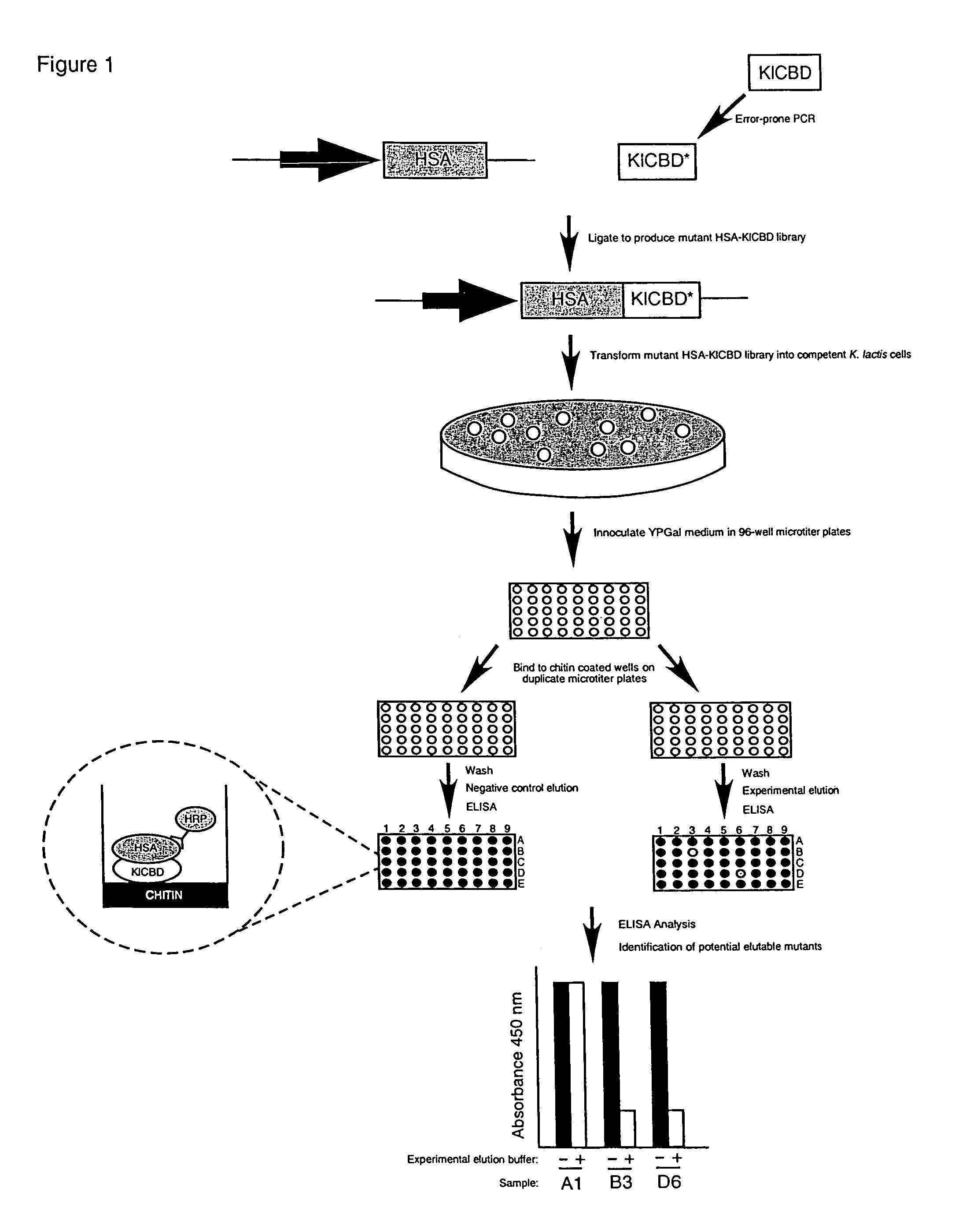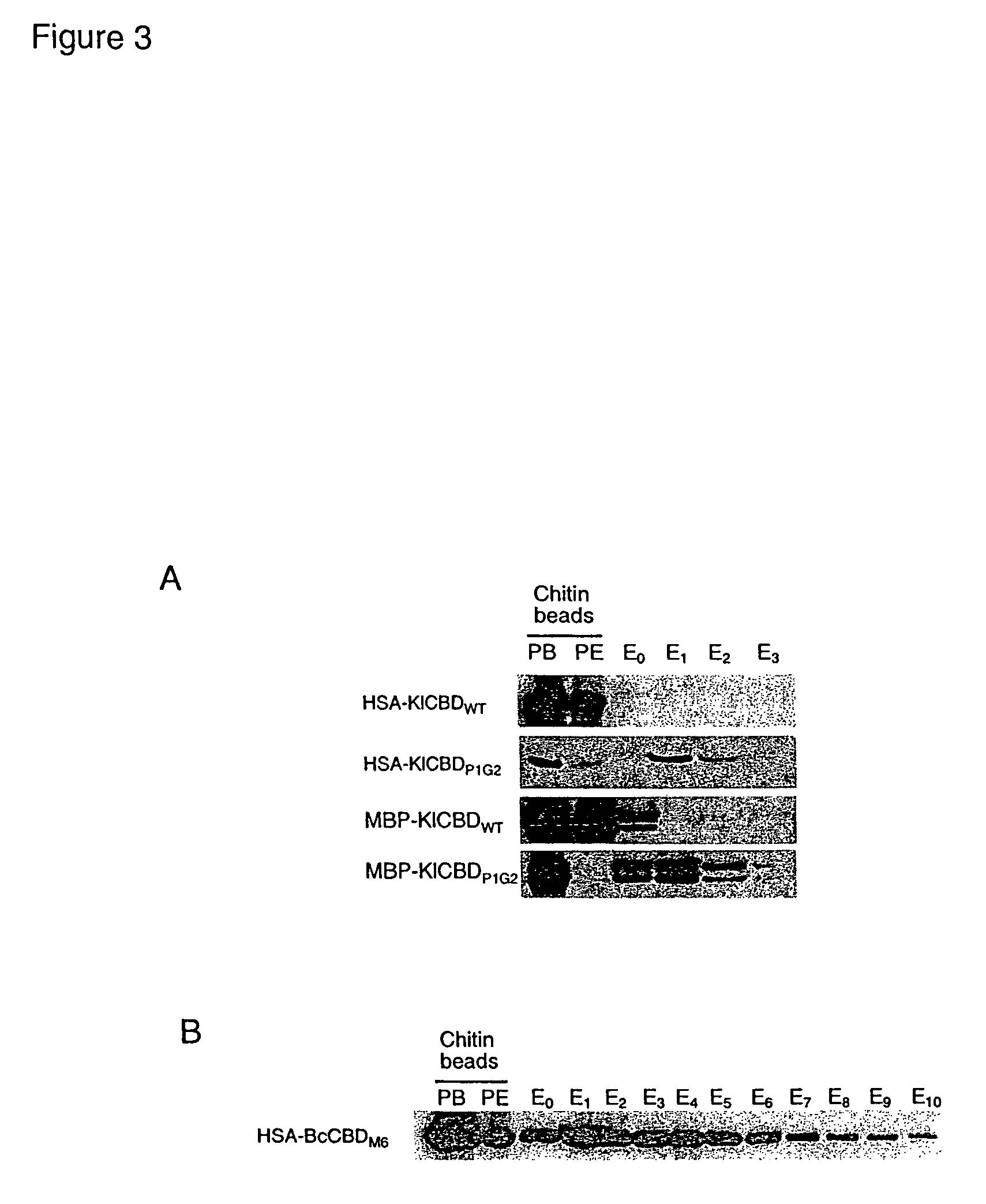Compositions and methods relating to elutable carbohydrate-binding proteins
a technology of elutable carbohydrate and elutable, which is applied in the field of compositions and methods relating to elutable carbohydrate-binding proteins, can solve the problems of preventing the cost-effective processing of large volumes of cell lysate or spent culture medium
- Summary
- Abstract
- Description
- Claims
- Application Information
AI Technical Summary
Benefits of technology
Problems solved by technology
Method used
Image
Examples
example 1
A Screen for ChBD Mutants that Conditionally Dissociate from Chitin
[0038]A library of randomly mutagenized DNA fragments encoding KlChBD or BcChBD were cloned into a K. lactis expression vector (pKLAC1) containing DNA encoding human serum albumin (pKLAC1-HSA) to create inframe fusions between the C-terminus and N-terminus of HSA and KlChBD or BcChBD mutants, respectively. An HSA PCR fragment was amplified with the forward primer CCGCTCGAGAAAAGAGATGCACACAAGAGTGAGGTTGCT (SEQ ID NO:5) and reverse primer CGCGGATCCTAAGCCTAAGGCAGCTTGACTTGC (SEQ ID NO:6) containing XhoI and BamHI restriction sites at their 5 prime ends, respectively.
[0039]The forward primer additionally contains two codons encoding lysine and arginine immediately 3′ of the XhoI restriction site. These codons constitute the K. lactis Kex1 proteolytic cleavage site. This site provides an in-frame fusion of HSA with the K. lactis alpha-mating factor pre-pro leader sequence present in pKLAC1 that directs protein secretion and ...
example 2
Identification of KlChBDP1G2—a ChBD Mutant that Dissociates from Chitin in the Presence of Reducing Agent
[0052]Two hundred HSA-KlChBD mutants were screened and one mutant, KlChBDP1G2, was found to conditionally dissociate from chitin. KlChBDP1G2 contains a single base change that results in the amino acid change G524S and a base deletion resulting in a frameshift that causes premature termination and changes in the three C-terminal amino acids F542L, T543L and Y544I (see FIG. 2A). These mutations resulted in the elution characteristics of KlChBDP1G2. The serine residue in G524S can be conservatively replaced with a threonine to maintain elution characteristics.
[0053]Early termination of KlChBD at L545 in conjunction with the G524S mutation (see FIG. 2A) resulted in a mutant that has 40% elution efficiency compared to KlChBDP1G2, suggesting that the KlChBD C-terminal seven amino acids play an important role in stabilizing the chitin-KlChBD interaction. Furthermore, the C-terminal 10 ...
example 3
Identification of BcChBDM6—a ChBD Mutant that Elutes from Chitin in the Absence of Salt at pH 8-9
[0055]Nine hundred and sixty HSA-BcChBD mutants were screened and one mutant, BcChBDM6, was found to conditionally dissociate from chitin. BcChBDM6 fusion proteins bound to chitin directly in spent yeast culture medium and remained bound upon washing with buffers containing 1 M NaCl. Dissociation from chitin occurred in buffers lacking salt that were in a pH range of between 8 and 9. The BcChBDM6 mutant was found by sequencing to contain two point mutations resulting in P680H and V692I amino acid changes. The requirements for elution of BcChBDM6 were established by examining the two mutations separately or together.
PUM
| Property | Measurement | Unit |
|---|---|---|
| pH | aaaaa | aaaaa |
| pH | aaaaa | aaaaa |
| pH | aaaaa | aaaaa |
Abstract
Description
Claims
Application Information
 Login to View More
Login to View More - R&D
- Intellectual Property
- Life Sciences
- Materials
- Tech Scout
- Unparalleled Data Quality
- Higher Quality Content
- 60% Fewer Hallucinations
Browse by: Latest US Patents, China's latest patents, Technical Efficacy Thesaurus, Application Domain, Technology Topic, Popular Technical Reports.
© 2025 PatSnap. All rights reserved.Legal|Privacy policy|Modern Slavery Act Transparency Statement|Sitemap|About US| Contact US: help@patsnap.com



